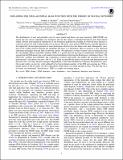EXPLAINING THE STELLAR INITIAL MASS FUNCTION WITH THE THEORY OF SPATIAL NETWORKS
Author(s)
Chilingarian, Igor; Klishin, Andrei
DownloadKlishin-2016-EXPLAINING THE STELL.pdf (1007.Kb)
PUBLISHER_POLICY
Publisher Policy
Article is made available in accordance with the publisher's policy and may be subject to US copyright law. Please refer to the publisher's site for terms of use.
Terms of use
Metadata
Show full item recordAbstract
The distributions of stars and prestellar cores by mass (initial and dense core mass functions, IMF/DCMF) are among the key factors regulating star formation and are the subject of detailed theoretical and observational studies. Results from numerical simulations of star formation qualitatively resemble an observed mass function, a scale-free power law with a sharp decline at low masses. However, most analytic IMF theories critically depend on the empirically chosen input spectrum of mass fluctuations which evolve into dense cores and, subsequently, stars, and on the scaling relation between the amplitude and mass of a fluctuation. Here we propose a new approach exploiting techniques from the field of network science. We represent a system of dense cores accreting gas from the surrounding diffuse interstellar medium (ISM) as a spatial network growing by preferential attachment and assume that the ISM density has a self-similar fractal distribution following the Kolmogorov turbulence theory. We effectively combine gravoturbulent and competitive accretion approaches and predict the accretion rate to be proportional to the dense core mass: dM/dt ∝ M. Then we describe the dense core growth and demonstrate that the power-law core mass function emerges independently of the initial distribution of density fluctuations by mass. Our model yields a power law solely defined by the fractal dimensionalities of the ISM and accreting gas. With a proper choice of the low-mass cut-off, it reproduces observations over three decades in mass. We also rule out a low-mass star dominated "bottom-heavy" IMF in a single star-forming region.
Date issued
2016-06Department
Massachusetts Institute of Technology. Department of PhysicsJournal
Astrophysical Journal
Publisher
IOP Publishing
Citation
Klishin, Andrei A., and Igor Chilingarian. “EXPLAINING THE STELLAR INITIAL MASS FUNCTION WITH THE THEORY OF SPATIAL NETWORKS.” The Astrophysical Journal vol. 824, no. 1, 17, June 2016, pp. 1-8. © 2016. The American Astronomical Society.
Version: Final published version
ISSN
1538-4357
0004-637X